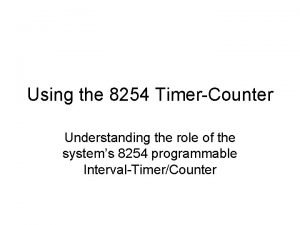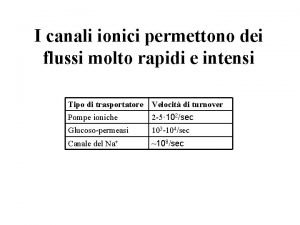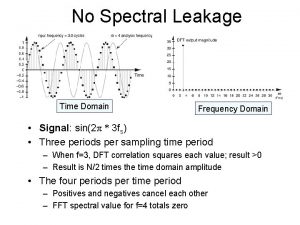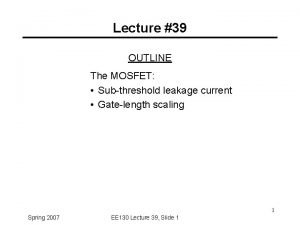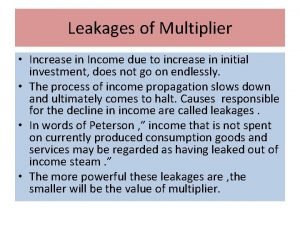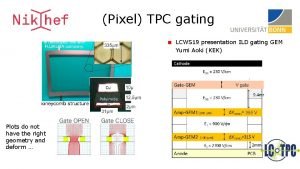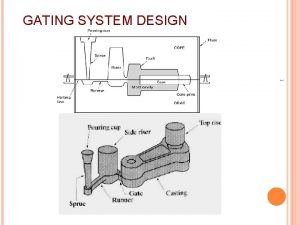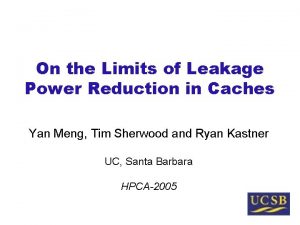ActiveMode Leakage Reduction with DataRetained Power Gating Andrew
















- Slides: 16

Active-Mode Leakage Reduction with Data-Retained Power Gating Andrew B. Kahng†, Seokhyeong Kang† and Bongil Park* †UC San Diego, *Samsung Electronics

Outline • Background and Motivation • Data-Retained Power Gating – Integrated Clock and Power Gating – Flip-flop implementation • Experimental Results • Conclusions and Ongoing Work 25 -Oct-21 VLSI CAD Laboratory / UC San Diego 1

Power Gating & Clock Gating Power gating Clock gating • Reduce leakage power with switch between vdd (vss) and a circuitry • Does not address active leakage • Reduce dynamic power by masking clock signal • Automatic application is supported by EDA tool Active leakage can be reduced by combining clock gating & power gating 25 -Oct-21 VLSI CAD Laboratory / UC San Diego 2

Run-Time Power Gating (RTPG) Run-Time Power Gating • Clock enable is “ 0” power switch is off • Drawbacks: * Usami et al. ICCD 2006 (1) design complexity, (2) large area overhead (bus holder), and (3) inrush current overhead Our work: Data-Retained Power Gating (DRPG) • Enable concurrent clock and power gating on flip-flops • Introduce a data retention switch, which has small design/area and inrush current overhead 25 -Oct-21 VLSI CAD Laboratory / UC San Diego 3

Data-Retained Power Gating (DRPG) Integrated Clock and Power Gating • We apply power gating scheme to flip-flops during clock gating (w/ sleep switch) • Internal data is retained with a retention switch, which sustains voltage level of virtual ground 25 -Oct-21 VLSI CAD Laboratory / UC San Diego 4

Data-Retained Power Gating (DRPG) • SPICE simulation results (DFQ flip-flop in TSMC 65 GP) Power-gated, clock disabled period (a) In-rush current (x) is small due to suspended virtual ground, and in-rush overhead is compensated in (y) virtual ground voltage (b) in-rush current (x) active leakage reduction (y) compensated current • During power-gating, retention switch sustains voltage (0. 25 V) (a) retaining data, (b) significant leakage saving (35%) 25 -Oct-21 VLSI CAD Laboratory / UC San Diego 5

DRPG: Flip-Flop Implementation • Nonzero output from suspended virtual ground causes significant leakage overhead level shifter circuit is required Added switches (P 0, N 1) before the final buffer to reduce delay and area overhead over conventional level shifter 25 -Oct-21 VLSI CAD Laboratory / UC San Diego 6

Physical Implementation • Implementation with a global power gating – Three modes (static leakage saving, active leakage saving and normal operation) are available • Standard cell implementation for a multi-bit flip-flop – Include sleep and retention switch inside the standard cell PGEN: global power gating enable CKEN: clock enable signal 25 -Oct-21 VLSI CAD Laboratory / UC San Diego 7

Physical Implementation • Physical layout of four-bit DRPG flip-flop, which shares a single sleep switch Switch N-Well Level shifter part within DRPG F/F VDD P-Well Real GND Virtual GND Real GND N-Well VDD Additional power routing Physical layout can have small area overhead by sharing virtual ground and switches 25 -Oct-21 VLSI CAD Laboratory / UC San Diego 8

Outline • Background and Motivation • Data-Retained Power Gating – Integrated Clock and Power Gating – Flip-flop implementation • Experimental Results • Conclusions and Ongoing Work 25 -Oct-21 VLSI CAD Laboratory / UC San Diego 9

Delay vs. Leakage Comparison leakage power (u. W) 14, 000 12, 000 10, 000 8, 000 6, 000 4, 000 2, 000 0, 100 25 -Oct-21 • Data-retained flip-flop normal FF (NVT) gives (~40%) leakage normal FF (HVT) reduction with (~15%) normal FF (Lgate bias) delay overhead vs. data-retained FF (LVT) conventional flip-flop data-retained FF (NVT) data-retained FF (HVT) • Extends available delay data-retained FF (Lgate bias) vs. leakage tradeoff � more choices for cell optimization 0, 150 0, 200 normal FF (LVT) cell delay (ns) VLSI CAD Laboratory / UC San Diego 10

Validation of Data-Retained Power Gating • For correct operation, wake-up latency should be less than the gated clock signal • Implemented results with TSMC 65 library – CG delay(EN-to-Q) + CTS buffer delay = typically >200 ps – Wake-up latency = ~30 ps 25 -Oct-21 VLSI CAD Laboratory / UC San Diego 11

Leakage Reduction for Implemented Design • Implementation flow: (1) Liberty preparation for data-retained flip-flops (2) synthesis with clock-gating and DRPG flip-flop insertion (3) place and route • Breakdown of area for implemented design CG FFs 100% Comb. logics Logic non-CG FFs 80% 60% CG FFs: clock-gated flip-flops 40% 20% AE VLSI CAD Laboratory / UC San Diego ER H IP S_ C O N M AX 80 S C TV B_ D O C U _E N EG JP W ER F SB A B_ D M C M W ET H 2 E 3 G BR I_ PC 25 -Oct-21 ID PE M VG A_ EN H G 2 0% Open source designs from Open. Cores 12

Leakage Reduction for Implemented Design • Leakage reduction for different timing constraints (tight: min. clock period. normal/loose: tight+20/50%) 30, 0% tight constraint normal constraint loose constraint 25, 0% 20, 0% leakage reduction: up to 21. 8 % (avg. 11. 3 %) with normal constraint 15, 0% 10, 0% 5, 0% ER C S_ AE B_ C O N IP H M AX 80 S TV D O C _E N EG W ER F SB D B_ U M A C W 2 ET H M JP PC I_ BR ID G E 3 G PE M VG A_ EN H 2 0, 0% – Leakage reduction varies with (1) portion of clock-gated flip-flops and (2) timing constraint (flip-flops in critical paths cannot be replaced by DRPG flip-flops) 25 -Oct-21 VLSI CAD Laboratory / UC San Diego 13

Conclusion and Future Work • We propose a new circuit-level technique to enable power-gating of clock-gated flip-flops during active mode • DRPG reduces leakage power over conventional designs by up to 21. 8% (average 11. 3%) with normal timing constraint and average of 3% area overhead • Future work – Extend the DRPG technique to combinational logic – Other data-retention strategies (for SRAM or combinational logic) to enable active-mode power gating 25 -Oct-21 VLSI CAD Laboratory / UC San Diego 14

Thank you 25 -Oct-21 VLSI CAD Laboratory / UC San Diego 15
 Set_clock_gating_style
Set_clock_gating_style Modes of 8253
Modes of 8253 8254 timer clock gating
8254 timer clock gating Boolean gating flow cytometry
Boolean gating flow cytometry Raggio anidro
Raggio anidro Power traiangle
Power traiangle Effects of electric current on human body
Effects of electric current on human body Spectral leakage
Spectral leakage Claims leakage control
Claims leakage control Subthreshold leakage current equation
Subthreshold leakage current equation Leakages of multiplier meaning
Leakages of multiplier meaning Elcb definition
Elcb definition Iec 60601 leakage current limits
Iec 60601 leakage current limits Electrical safety analyzer
Electrical safety analyzer Eli p llc clean air
Eli p llc clean air Dcm305
Dcm305 Cmos leakage current
Cmos leakage current


